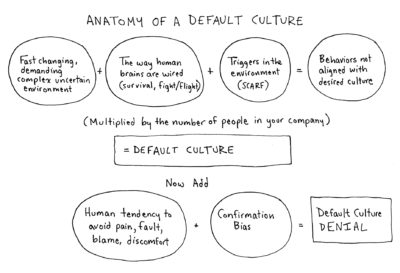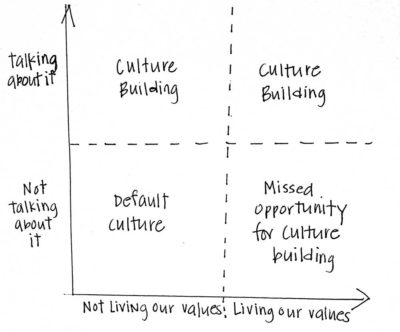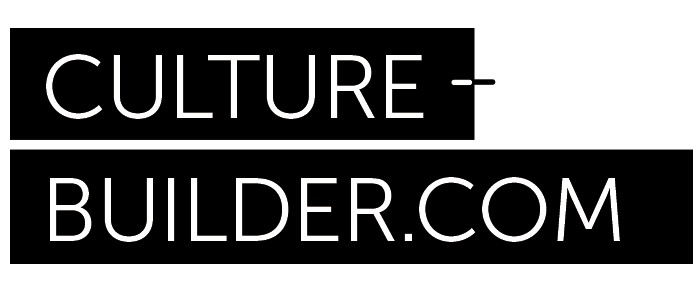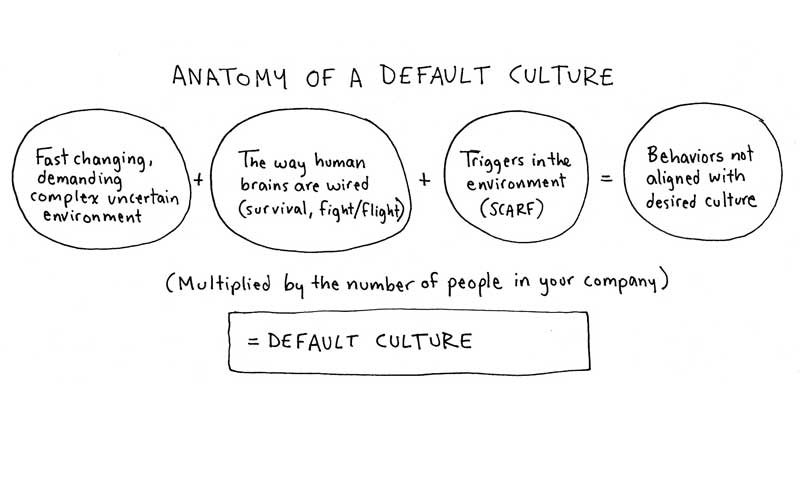By Simon D’Arcy
When a team or company is trying raise the bar on their culture, there are two equally important things to pay attention to:
- Moments when you are living the culture you aspire to (“culture moments”)
- Moments when you are NOT living the culture you aspire to (“not culture moments”).
Ignoring half of reality will not work when you’re building a thriving team and company culture.
One major reason why many culture-change efforts don’t gain traction is because, in an earnest effort to create a better culture, leaders and managers focus on the positive side and ignore the “not culture moments.” When leaders ignore the moments when the team members aren’t living up to the culture standards, the behaviors and issues can’t be addressed. Instead they are covered up, out of sight.
Last year, I met with an executive of a Bay Area tech company. This company has spent the past year defining their culture. They had done a better job than most at clarifying their values as well as defining those values in specific behavioral terms—a piece many companies miss.
To top it off, they included hundreds of employees in the process so that it was a collective, creative process versus a top-down approach. Everyone in the company did a three hour workshop on these values led by their own leaders. So far so good. The challenging part is what comes next.
This executive leader expressed feeling disappointed that he wasn’t seeing more evidence of behavior change after having defined the company’s new values.
When I asked about what he meant, he told me about the hours of meetings he had the week before diffusing a conflict between a marketing team and a product team. People were reverting back to their old behaviors: blaming, withholding information and avoiding having hard conversations. He said, “Everybody seemed to be fired up when they did the culture workshops last year. How come it didn’t stick?”
The short answer is “Default Culture.”

What is “Default Culture?”
Default culture is automatic and unavoidable. It’s the habit of human reactiveness reasserting itself when things get stressful.
Here are four symptoms that indicate your company’s culture is falling into default behavior
- “Us vs. Them” thinking – the false belief that we have to work in opposition to each other even though we share a common purpose. Common examples, include: sales vs. product, corporate office vs. the field, sales vs. engineering.
- Absence of accountability – Which inevitably leads to some version of the blame game.
- Unnecessary drama – when people feel blamed, they get defensive, self-righteous, and start mis-trusting each other’s intentions.
- Issue avoidance; superficial conversations – Once trust starts to break down, it becomes easier to just avoid having direct conversations which leads to more distrust, more drama and less results.
Does any of this seem familiar? Unfortunately, the answer is probably yes.
No one wants to work in an environment like this. Rational people don’t intentionally set out to create this sort of behavior and these sorts of relationships at work. So how do these behaviors persist?
Default culture arises and persists as a result of how our brains are wired
Our brains have been perfected over thousands of years to perceive threat and to protect us from harm. However, our brains have not quite evolved enough to be able to differentiate the somatic bodily response to threat levels. For example, what our brain considers a threat is not as serious as an attacking tiger. Instead, the threat is an “ego threat.” In other words, our reactive circuits can get worked up over a whole lot of nothing.
In the article “Managing with the Brain in Mind” David Rock writes about five conditions that will reliably trigger a threat response in our brain. See if you recognize any of them in your work environment:
- Status differential: When a senior leader (think your boss’s, boss) comes into the room, the level of honest debate quickly declines. That’s because evolutionarily, people often become more agreeable and submissive in the company of the alpha.
- Uncertainty: The more uncertainty there is in an environment, the more likely we are to become stressed and reactive. In that state, we do and say things that are not in our highest possibilities.
- Lack of autonomy: When we don’t perceive we have a choice, we can go into reaction.
- Disconnection: Feeling separate from others can trigger reactivity. For example,how many mass shootings are committed by people who feel included, seen and loved?
- Lack of Fairness: When we perceive something to be unfair, it can often trigger a reactive, victim mindset.
As human beings, we are wired to survive. Our limbic brain, the automatic, feeling, quick-reacting part of our mid-brain, interprets ambiguity, uncertainty and differences with others as a potential threat and acts accordingly.
In a company setting, it means that a group of people interacting under the stress of fast-paced timelines, with complex and uncertain circumstances will work from their limbic brains. This cycle of triggering the fairly uninspiring ‘default culture’ undermines many well-intended leadership and culture efforts.
Here’s the kicker: Default culture isn’t the problem. It’s just humans being humans together. The “problem” (if there is one) is ignoring the situations and behaviors that trigger the phenomenon.
Default Culture Denial
Discussing default culture behaviors might be challenging, especially for those who want to bypass conflict and stay positive. However, addressing default culture behaviors is the key to assisting employees in a) increasing their capacity for dealing with normal tensions without drama and b) having more choice in how their limbic brains react to challenging situations. In fact, addressing specific situations and behaviors within a team can help employees develop personally and professionally.
On the other hand, when unwanted behaviors are left unaddressed, they become resentments, and they become much harder to address as time goes on.
It works like this….

What to do about it?
So the question is this: What is the best way to respond individually, interpersonally and organizationally—to behaviors that are not in line with the values we say we care about?
Individually, instead of ignoring “default culture” moments, we can deliberately seek them out and embrace them as opportunities to reinforce our desired culture. For instance, if one of our cultural aspirations is to listen and be curious, I can start making note of the moments when I am NOT curious—when I feel I am right and the other person is definitely wrong.

When I can catch myself in this moment, and name it (at least to myself), a new “culture-building choice” becomes available: I can choose to intentionally shift my mindset from one of “listening to be right” to one of “listening to learn.” This is a culture building moment.
As a team, the best way to attend to default culture is to leverage the power of making (and keeping) explicit agreements with each other regarding how you will support one another in “not culture moments.”
When we work with executive teams at Evolution, we help them build these kind of agreements into their team charter and coach them in how to hold each other accountable to the agreements. When team members see their leaders walking the talk, the culture building effort gains traction.
Culture building is a constant activity. If you want to accelerate your team’s progress, then intentionally look for opportunities to catch yourself in a default culture moment and recover from it in public to make an example of yourself. It can be an especially potent form of culture building when leaders reveal what’s happening for them publicly and it becomes a teachable moment for others. This is one way your desired culture gets transmitted. You are what you do, and how you do it, not what you say you will do.
Default isn’t an option for culture builders. You can’t change what you can’t accept. Creating a thriving team and workplace culture starts with noticing and acknowledging default culture (without shaming it). You can’t just wallpaper over it. You can’t go around it. You must reveal it, own it and put in the work to shift out of it, making a different choice.
You get the culture you’re willing to practice into existence every day.
Simon D’Arcy Curator @ Culture-Builder.com Partner at Evolution. Champion of the Culture Builders Manifesto.
Get the Culture Building Report

You'll learn the road map for designing, embedding and activating culture in your team or company.

